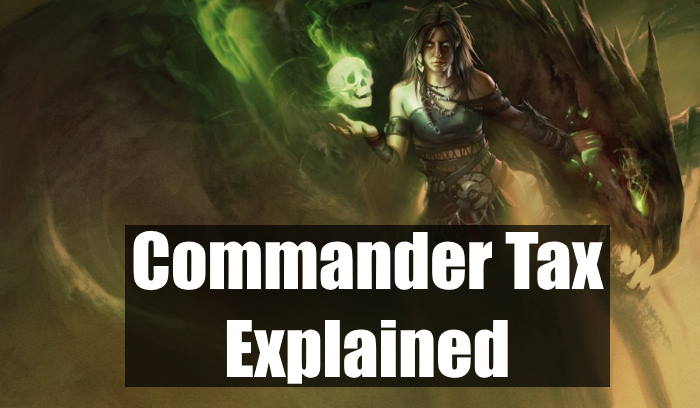Commander has become the most popular way to play Magic: the Gathering. Not only does it let you play with a larger group, but it also lets you draw on cards from throughout Magic’s history. Of course, it also introduces quite a few new rules, inlcuding the command zone and commander tax.
Your commander starts each game in the ‘command zone,’ and you can cast it from that zone throughout the game. Whenever your commander changes zones, such as when it dies, you can put it back into the command zone. This means you’ll always have access to your commander, but that access comes with a price. For each additional time you cast your commander from the command zone, you have to pay two generic mana. This is called the ‘commander tax,’ and it’s an important mechanic in EDH.
Of course, there are ways to work around commander tax. You should also know how it interacts with other rules so you can always make the right play. Whatever you’re looking for, we’ll walk you through everything you need to know about this key commander mechanic.
Table of Contents:
How Does Commander Tax Work?
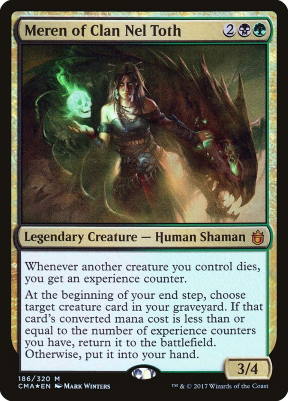
Before we take a look at specific interactions, let’s review how commander tax works.
A player may cast a commander they own from the Command Zone. A commander cast from the command zone costs an additional {2} for each previous time the player casting it has cast it from the command zone that game. This additional cost is informally known as the “Commander tax.”
Commander rule 903.8
In every game of EDH, you start with your commander in the command zone. You can cast your commander whenever you normally could, assuming you have the mana to pay for it. If your opponents remove it, you can choose to bring it back to the command zone so you can cast it again. After all, plenty of EDH decks rely on their commander for their strategy to work, so removing one of these creatures for the rest of the game could ruin someone’s plan too easily.
RELATED: MTG Commander: The Ultimate Guide
However, that doesn’t mean removal is useless against commanders. Each time you cast a commander from the command zone, you have to pay two generic mana for every time you’ve already done so. The first time you cast Hapatra, Vizier of Poisons, she costs two mana. The second time, she costs the original two plus two generic mana, then four generic mana, then six, and so on.
If your commander gets removed enough times, it can get close to impossible to cast them again. For expensive commanders, this is an even bigger issue. In this way, commander tax gives you access to your key card while letting your opponents have some counterplay.
Do You Have to Pay Commander Tax for Alternative Costs?
Yes. Even if you pay an alternative cost, you’re still casting the card.
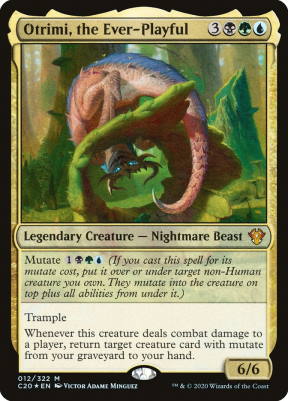
As an example, let’s assume you’re playing an Otrimi, the Ever-Playful deck. You cast Otrimi, it dies, and then the game continues. A few turns later, you could either cast Otrimi as a creature spell or cast it for its mutate cost. If you cast it normally, you’d have to pay eight mana total (six for its casting cost and two for commander tax). If you mutate it, you’d have to pay six (four for its mutate cost and two for commander tax).
RELATED: MTG Mutate: How It Works
Either way, you have to pay the tax. You can still get a discount by mutating it, but you can’t avoid commander tax if you cast it from the command zone.
Does Commander Tax Count Towards Mana Value?
No. The mana value of a card is the total amount of mana in its casting cost (not including X spells). Any extra mana you have to pay, or any mana that gets reduced, doesn’t count.
What Changes with Partners?
Each partner has their own separate commander tax that you have to pay.
Let’s assume you have Brallin, Skyshark Rider and Shabraz, the Skyshark as commanders. If you cast Brallin three times from the command zone, you’d have to pay an extra six mana the next time you wanted to cast him from there. If you haven’t cast Shabraz throughout the entire game, though, you wouldn’t have to pay any tax to cast it.
Can You Avoid Commander Tax?
Of course, the less often you have to pay commander tax, the better. Not only do you waste time by recasting the same card over and over, but it also becomes increasingly inefficient to do so. Luckily, you have lots of options to play around commander tax.
Cast from Other Zones
You may have noticed that you don’t have to pay tax every time you cast your commander. It only applies when you cast it from the command zone, which you don’t necessarily have to do.

Some removal spells, like Cyclonic Rift, put cards back into your hand. Whenever your opponent bounces your commander instead of killing it, it’s often better to keep it in your hand. If you put it back into the command zone, you’ll just have to pay extra mana. If you cast it from your hand, however, you get to cast it for its normal cost. Casting your commander from your hand also doesn’t increase the tax if you have to cast it from your command zone later in the game.
Of course, most removal spells in Magic don’t return creatures to your hand: they destroy them. If your commander ends up in the graveyard, though, that doesn’t mean you can’t get it back.
Some spells let you return creatures from your graveyard to the battlefield, such as Reanimate or Victimize. Not every color has access to these cards, however, and not every deck wants to run them. Still, you can often get away with running one or two of these in just about any black deck, and they’ll give you extra resiliency. If you draw them at the right time, you might even be able to avoid paying commander tax.
Of course, this is a risky plan. If your spell gets countered, your commander could be stuck for the rest of the game. You should really only plan around this if you already have the reanimation spell and you know you can pull it off.
Cost Reduction
If you find yourself paying extra mana, then reducing the costs of your spells will naturally balance that out. This strategy won’t let you avoid commander tax entirely, but it will help you pay for that extra cost.
Cards like Jet Medallion are already powerful additions to the right deck. If your commander also happens to work with these spells, then you can mitigate commander tax without putting in much work.
Some commanders also reduce their own cost. Hamza, Guardian of Arashin, for example, costs one generic less for each creature you control with a +1/+1 counter on it. This reduction also applies towards commander tax, so you could still pay just two mana for it if you had the right

There aren’t too many effects in MTG that reduce the costs of your spells, but it’s a powerful effect that works around commander tax quite well.
Protect Your Commander
Lastly, you can try to stop your commander from dying in the first place. Even if you can’t protect it for the entire game, stopping your opponents from killing it once or twice could save you a lot of mana in the long run.
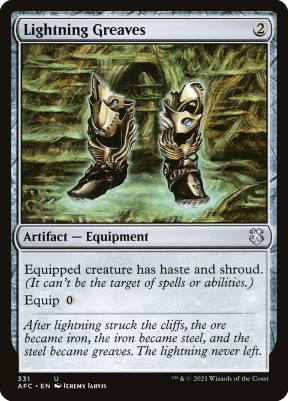
Some of the best equipment in MTG helps you keep your best creatures on the
RELATED: MTG Shroud vs Hexproof: Which Is Better?
If you’re relying on your commander, these cards can be extremely useful. Scary commanders like Atraxa, Praetors’ Voice or Korvold, Fae-Cursed King can be easy targets for removal. Keeping them around for as long as possible not only lets you avoid paying the tax, but also moves your gameplan forward.
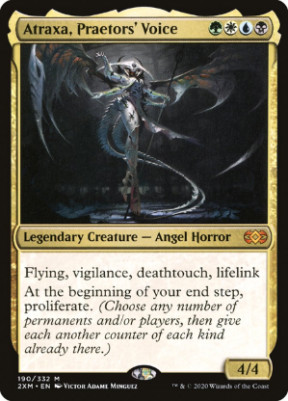
You might also want to try protecting your creatures with deals instead of cards. Not everyone enjoys the political side of EDH, but making the right deal at the right time can win you the game. If you can convince your opponents to remove other targets, you can focus on getting ahead instead of rebuilding your
How Do I Build Around Commander Tax?
Now that we know what commander tax does and how to work around it, how should this impact deckbuilding? Since commander tax will be a factor in just about every EDH game, it’s important to consider how your deck plays around it.
First, you can include more of the cards we’ve just talked about. Lightning Greaves can work in just about any deck, so take a moment to consider whether it fits into yours. Maybe instead you want to include mana reduction, or just more ramp so you can pay for the tax. Whatever you decide, make sure you have a plan if your commander kicks the bucket.
Who’s Your Commander?
It’s also important to know how much you need to play around commander tax. For some decks it can be a big issue, but others could care less.
Some decks can avoid commander tax without any extra effort, such as Yuriko, the Tiger’s Shadow. Commander ninjutsu is an activated ability, not an alternative casting cost. This means you can always pay two mana to ninjutsu her onto the battlefield, no tax required. Other decks just aren’t built around their commander. If you don’t need your commander to make your gameplan work, then you likely won’t cast it more than once or twice anyway.
However, most decks use their commander as a key part of their engine. These decks need to have a plan to work around commander tax. The more important the commander, the more you need to plan around it.
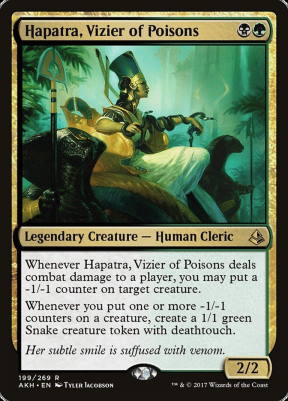
Let’s look at Hapatra, Vizier of Poisons again. Only a couple of cards have a similar effect, so it’s important to keep her around as often as you can. Luckily, she only costs two mana. This means that you can cast her multiple times from the command zone without much extra work. Still, that doesn’t mean you want to let her die four, five, or more times.
If your commander is expensive, then commander tax will be a much larger issue for you. Decks built around Kenrith, the Returned King often try to use his abilities to win the game. He’s very important for his decks’ gameplan, but he also costs five mana. Once your opponents remove him two or three times, it can be back-breaking to get him back onto the battlefield. Keeping the tax low is especially important for expensive commanders.
End Step
Commander tax might seem like a small part of EDH, but it can actually play a huge role in both deckbuilding and gameplay. I hope this article has shown you both when and how you should play around the tax. No one wants to pay extra mana for their spells, so keep your commanders safe out there!
